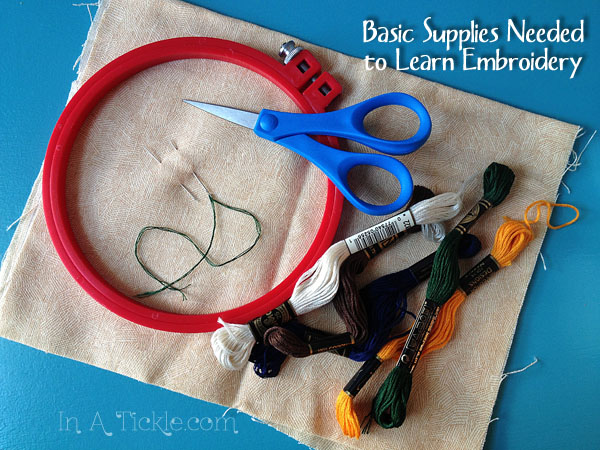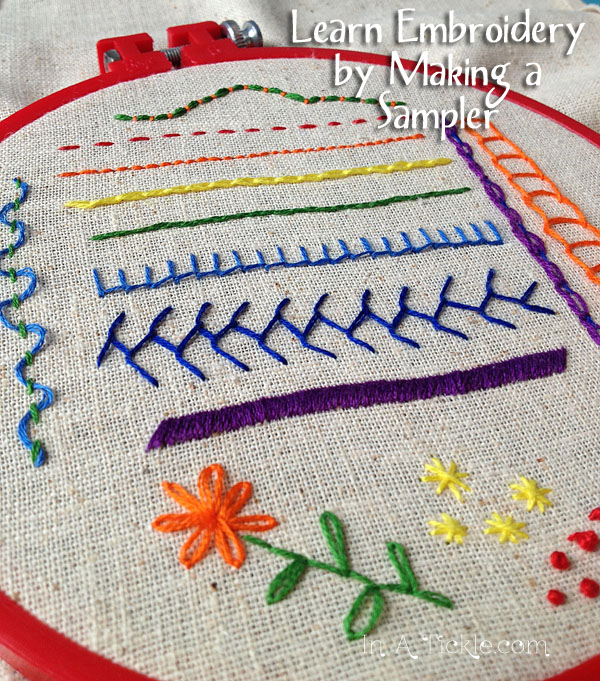I learned to embroider from my mom and grandmothers when I was a young girl. When my children were small, I spent many hours working on projects. Embroidery was a hobby that I could easily carry with me and work on while I watched the kids play. A close friend and I often got together to sit, talk and work on our handwork projects while our children played together. (I don’t remember that we called them “play dates” back then. I think it was for our sakes that we got together, the bonus for the kids was they got to play with someone else!)
If you are looking for a new hobby, embroidery is easy to learn and inexpensive to start. You don’t need fancy equipment or lots of space. You can get started for less than $12.00.
The basics you will need are:
1. Embroidery Needles
2. Embroidery Hoop (a medium size will work just fine)
3. Embroidery Floss (you can start learning the stitches with just one color)
4. Scissors to cut embroidery floss
5. Fabric to embroider (you can start with a scrap just a little bigger than your hoop or start learning stitches on an old t-shirt or other garment) DMC, a company that makes embroidery floss, has excellent information and tutorials to get you started from transferring a design to your fabric, to putting the fabric in the hoop, to threading the needle and getting started stitching. Visit their site to learn more.
DMC, a company that makes embroidery floss, has excellent information and tutorials to get you started from transferring a design to your fabric, to putting the fabric in the hoop, to threading the needle and getting started stitching. Visit their site to learn more.
You may have seen needlework samplers in antique stores. They usually have various stitch designs, letters of the alphabet, and so forth stitched on them with different color threads. They were commonly done as practice learning pieces to develop skills in needlework as well as to demonstrate knowledge. But long before the age of social media, samplers were also the early form of “pinning” to remember stitch work.
According to Wikipedia, “The oldest surviving samplers were constructed in the 15th and 16th centuries. As there were no pre-printed patterns available for needleworkers, a stitched model was needed. Whenever a needlewoman saw a new and interesting example of a stitching pattern, she would quickly sew a small sample of it onto a piece of cloth – her ‘sampler’. The patterns were sewn randomly onto the fabric as a reference for future use, and the woman would collect extra stitches and patterns throughout her lifetime.” Many of these samplers were considered valuable and passed on to heirs.
Perhaps a good way for you to start learning to embroider would be to make your own sampler. Just start by making a short line of one stitch. Then start another line of embroidery learning another stitch. It’s fun to try new stitches and much less intimidating to try out stitches on a sampler.  After you have tried the basic stitches on the DMC site, you can find other variations and more intricate stitches on this site, called Sarah’s Hand Embroidery Tutorials. She also features unique embroidery stitches from various countries.
After you have tried the basic stitches on the DMC site, you can find other variations and more intricate stitches on this site, called Sarah’s Hand Embroidery Tutorials. She also features unique embroidery stitches from various countries.
Have fun stitching!


You have a nice story. Thanks
I was like you but in addition to traditional embroidery, I’ve discovered cross-stitching.
I have some skills plus read a book (this one goo.gl/pcbCG4 was good). I’m so glad now I have 2 hobbies which need the same equipment!